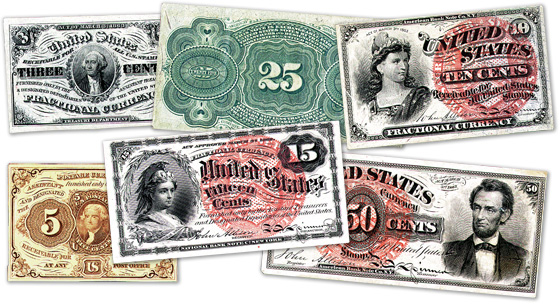Fractional Currency

Fractional Currency was issued for over a 14-year period from 1862-1876. The notes shown are examples selected from the numerous designs that were issued to combat attempts at counterfeiting. Many design changes were made for each of the six different denominations.
Once it became obvious that the federal Treasury did not have sufficient bullion reserves to finance the Civil War, the value of the dollar dropped drastically. Whatever coins were in circulation quickly disappeared as people hoarded as much "hard currency" (coins) as they could.
This caused major problems for both merchants and their customers, as small-denomination coins were needed to make change in everyday business transactions. To replace coins, people even began to use postage stamps!
From Postage Currency to Fractional Currency
Realizing the seriousness of the situation, in 1862 the government authorized the production of paper notes in values of less than one dollar. They were called "Postage Currency" because their designs resembled U.S. postage stamps of the time. One year later, the government authorized the release of additional issues of fractional value notes. These are known as "Fractional Currency." They continued to be issued for 14 years, until the production of small-denomination coinage was large enough to allow people to redeem their Fractional Notes for coins.
Out of the millions of dollars of Fractional Currency originally released by the government, most was redeemed for U.S. coins and destroyed over a century ago. Today, less than 1% is still unaccounted for. Most of the "survivors" are believed to be in the hands of collectors. And you may be surprised to know that, like all U.S. government currency issued since 1861, those Fractional Notes that have survived are still legal tender for their face value today! But because so few survive, they are highly prized by collectors.
See our inventory of Fractional Currency

